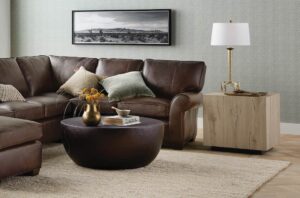Choosing between Joybird vs West Elm for your home furnishing needs? Both brands are esteemed for their distinct design sensibilities and quality materials.
But making the wrong choice can cost you time, money, and peace of mind. Joybird, an online furniture company, specializes in custom-made pieces inspired by the mid-century modern movement. West Elm, on the other hand, is known for its contemporary designs and commitment to sustainability.
Wondering which brand is better suited for you? This guide will detail everything from the origins of these companies to their warranty policies, helping you make an informed decision.
How Did These Brands Start?
Selecting the right furniture brand often involves understanding their origins and core values. Knowing how Joybird and West Elm started can offer valuable insights into their product quality and customer service. This section discusses the history of both companies, the driving missions behind them, and their environmental commitments.
When and Why Joybird Was Founded
Joybird emerged as an online furniture retailer with a focus on custom-made, hand-crafted home furnishings. Its core mission revolves around offering high-quality custom furniture at reasonable prices. The brand draws its inspiration from the mid-century modern movement, with designers like Frank Lloyd Wright playing a significant role in shaping its aesthetic.
Note: Joybird has showrooms in Brooklyn, Washington D.C., and Chicago, although it primarily operates online.
The Birth of West Elm
West Elm was launched in 2002 and operates under its parent company, Williams-Sonoma, and Pottery Barn. This high-end furniture and home decor brand distinguishes itself with modern designs and an emphasis on sustainability. West Elm prides itself on offering 60% of products that support at least one sustainability initiative.
Missions that Drive Both Brands
- Joybird: To offer high-quality, custom-made furniture at reasonable prices.
- West Elm: To bring modern design and sustainability into every home.
Both brands aim to combine quality with aesthetics but follow different paths to reach this goal. While Joybird places more emphasis on customization and hand-crafted elements, West Elm focuses on sustainability and modern design elements.
Going Green or Not
When it comes to environmental responsibility, West Elm clearly takes the lead. The brand focuses on sustainability by using materials like FSC-certified wood, organic cotton, and recycled elements. Joybird, although responsible in its sourcing of kiln-dried hardwood, doesn’t put a heavy emphasis on green initiatives.
This section gives a foundational understanding of Joybird and West Elm, shedding light on their origins, missions, and how they view environmental responsibility.
Read Also: Joybird vs Lovesac – A Comprehensive Comparison
What Makes Their Style Unique?
Design aesthetic is a crucial factor when choosing between Joybird and West Elm. Both brands bring unique styles to the table, shaped by distinctive inspirations and designers. This section delves into the uniqueness of each brand’s design offerings, providing insights that can help make your furniture decision easier.
What Inspires Joybird Designs
Joybird takes its cues from the mid-century modern era, a design movement that champions clean lines and minimalism. The brand emphasizes vibrant colors and playful patterns, aiming to make each piece a conversation starter.
Note: Joybird’s upholstery options are numerous, giving customers the flexibility to personalize their furniture extensively.
Who Designs for Joybird
The design team at Joybird is a group of skilled craftsmen who are passionate about creating pieces that echo mid-century modern ideals. Unlike many mass-produced items, Joybird furniture involves a hands-on approach, where designers are closely involved in the manufacturing process.
The Flavor of West Elm’s Style
West Elm leans towards a more refined and subdued aesthetic, echoing modern sensibilities. The brand frequently incorporates natural materials, such as wood and stone, to create a calming, earthy vibe.
| Material | Use in Design |
|---|---|
| Wood | Tables, Chairs |
| Stone | Countertops |
| Metal | Light fixtures |
Who’s Behind West Elm Designs
West Elm collaborates with a variety of independent artists and in-house designers to produce its collections. This approach not only brings diversity to the product range but also supports local artisans.
Understanding the design ethos of Joybird vs West Elm can significantly inform your purchasing choices. While Joybird allows for more personalized, vibrant decor, West Elm offers a sleek, modern elegance with a focus on natural materials.
Is the Furniture Built to Last?
One of the pressing questions for any furniture buyer is durability. The materials used and warranty terms can make or break the longevity of a piece. This section elucidates how Joybird vs West Elm approach durability, focusing on the types of wood, cushion fillings, materials, and warranties they offer.
The Wood in Your Joybird Sofa
Joybird predominantly uses kiln-dried hardwood for its sofas, ensuring that the wood is free from moisture and less prone to warping. The brand also employs robust corner blocking, a technique that reinforces corner joints, enhancing the structural integrity of its pieces.
Note: Kiln-dried hardwood is less susceptible to cracks and provides a sturdy foundation for your furniture.
What’s Inside Joybird Cushions
Joybird opts for high-resilience foam in its cushions, combined with down feathers for a plush yet supportive seating experience. These materials have been selected for their ability to maintain their shape and comfort level over time.
West Elm’s Choice of Materials
Unlike Joybird, West Elm often incorporates sustainable materials like FSC-certified wood and recycled fabrics. The brand is committed to reducing its environmental footprint while also ensuring the durability of its furniture.
| Material | Environmental Impact | Durability |
|---|---|---|
| FSC-certified wood | Low | High |
| Recycled Fabrics | Low | Moderate |
Warranty Offers You Can’t Ignore
Both brands offer compelling warranty options. Joybird provides a 365-day home trial and a limited lifetime warranty on specific parts, such as the frame and suspension. West Elm, on the other hand, offers a more conventional one-year limited warranty on furniture, but with the option to purchase extended protection plans.
By considering the materials used and warranty terms, you can better evaluate which brand is more likely to stand the test of time—Joybird with its focus on high-quality, durable materials, or West Elm with its emphasis on sustainability and optional extended warranties.
How to Assemble Your New Furniture
Assembly is often a significant concern when purchasing new furniture. As such, understanding how Joybird vs West Elm simplify this process can significantly influence your buying decision. We examine the assembly protocols of each brand, discussing the fees involved and the ease of assembly for customers.
Joybird’s Assembly Game Plan
Joybird furniture usually arrives partially assembled, requiring minimal effort to complete the setup. The company provides detailed instructions along with the necessary hardware. For larger items, the company recommends two persons for assembly, ensuring a smooth and efficient process.
Note: It’s advisable to have a power drill handy, although it’s not a requirement.
West Elm’s White Glove Touch
West Elm offers a more personalized experience through its “White Glove Service.” With this service, professionals come to your home to assemble the furniture for you. The convenience factor here is exceptionally high, as you don’t have to lift a finger.
Extra Fees to Know About
While Joybird usually includes the cost of assembly in the product price, West Elm’s White Glove Service comes with additional fees. These can range from $100 to $200 depending on the item and location. It’s essential to budget for these fees if you’re opting for West Elm.
| Service | Joybird | West Elm |
|---|---|---|
| Assembly Cost | Included | Extra ($100-$200) |
No-Sweat Assembly for Customers
Both Joybird and West Elm aim to make the assembly process as straightforward as possible for their customers. Joybird’s user-friendly instructions and included hardware make it easy for most people to assemble their furniture. Conversely, West Elm offers full-service assembly, albeit at an extra cost, to those who’d rather not engage in the assembly process.
By focusing on each brand’s assembly methods, costs, and customer convenience, we can appreciate the distinct approaches Joybird and West Elm take to eliminate assembly headaches.
What to Expect in Shipping
Shipping is a crucial aspect that can significantly impact your furniture buying experience. With this in mind, we scrutinize the shipping policies of Joybird and West Elm, discussing their timelines, costs, and what to do if your delivery is late.
Joybird’s Fast and Free Options
Joybird takes pride in offering fast and free shipping for all its products within the contiguous United States. Typically, the estimated delivery window is two to three weeks for most items. They make use of reputable shipping carriers to ensure the furniture arrives in pristine condition.
Note: Free shipping does not apply to Alaska, Hawaii, or international orders.
Why Joybird Might Be Late
While Joybird aims for prompt delivery, there can be unforeseen delays. Factors like natural disasters, labor strikes, or high-demand seasons can extend the delivery window. It’s advisable to keep an eye on your tracking information and to contact customer service for updates if your order is late.
West Elm’s Range of Delivery Choices
West Elm offers multiple shipping options, including standard, next-day, and even international shipping. However, these come at varying costs depending on the item’s size and your location. It’s critical to examine these factors to calculate your final cost.
| Shipping Type | Estimated Time | Cost |
|---|---|---|
| Standard | 7-14 days | Variable |
| Next-Day | 1 day | Premium |
| International | Varies | Highest Cost |
How Fast Can You Get a Sofa?
If you’re anxious to get your new sofa, both brands provide relatively quick options. Joybird typically takes two to three weeks for delivery, while West Elm’s standard shipping generally promises a 7-14 day window. For those in a hurry, West Elm offers a next-day delivery service, but keep in mind that this option comes at a premium cost.
In focusing on the shipping details, one can discern the distinctive shipping policies and practices that Joybird and West Elm have in place. This information is critical for making an informed decision that complements your needs and lifestyle.
Easy Returns or Headaches?
The return policy of a furniture company can be as important as the quality of the products themselves. Both Joybird vs West Elm offer ways to return purchases, but the terms, ease, and customer service can be quite different. Let’s dissect their respective return policies to give you a clearer idea of what to expect.
Joybird’s Friendly Return Policy
Joybird offers a straightforward and customer-friendly return policy. If you are dissatisfied with your purchase, you can return it within 14 days for a full refund. Notably, they also offer free return shipping, making the process less taxing on the customer.
Note: Custom orders are not eligible for returns.
Guarantees Joybird Offers
On top of their lenient return policy, Joybird also offers a 365-day home trial for specific items. If at any point within a year you are unhappy with your purchase, they’ll work with you to make it right, either by exchanging or issuing a refund.
| Policy | Duration | Eligibility |
|---|---|---|
| Return Policy | 14 days | All items except custom orders |
| 365-day Home Trial | 365 days | Selected items |
How West Elm Handles Returns
West Elm, in contrast, allows for returns within 30 days, but customers are responsible for the return shipping costs. Moreover, they charge a restocking fee for certain items, which can be a deal-breaker for some.
Customer Service Showdown
While both companies offer multiple channels to reach their customer service—phone, email, and chat—Joybird appears to be more responsive according to customer reviews. The experience you have during a return process could very well determine if you continue to patronize the brand in the future.
By closely inspecting the return policies and associated guarantees of both Joybird vs West Elm, one gains a comprehensive understanding of how each brand aims to address customer satisfaction and potential grievances. This information is crucial for consumers seeking to make informed purchasing decisions.
Read Also: Joybird vs Burrow? Making the Best Choice
Conclusion
The showdown between Joybird vs West Elm has given us rich insights into the furniture options available to consumers. From quality and design to customer service, each brand has its strong points and areas that might not suit everyone.
Both brands offer stylish, high-quality furniture but differ in their approaches to customer service and return policies.
Know your priorities—whether it’s customization, ease of return, or sustainability—as this will guide your choice between these two brands.
Before making your first purchase, pay attention to warranty offers and don’t shy away from utilizing customer service resources to answer any questions you may have.





